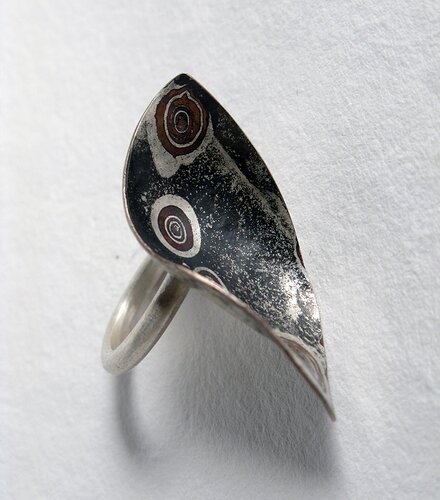Materials: sterling silver and copper - mokume gane
Dimensions: 4cm x 2cm x 1cm
Hand shaped ring of sterling silver and mokume-gane, inspired in the shape of an open wisteria pod. Silver and copper. Forged, laminated and chiselled.
Photo credit: Marcos Zimmermann
Valeria Elina Dowding
objetos-joya
Buenos Aires, Argentina
I was always fascinated by modes of expression that can involve most of the senses. Creating jewels opened for me the possibility to combine several things: the exploration of shapes, textures, colors and materials, and the pleasure of discovering their reactions in reply to different possible interventions (made by hand with intention, with tools, with fire; or by accident or chance and impossible to repeat voluntarily). To discover qualities, of hardness, ductility, change of state, textures is a very magical and sensual exploration. To follow this path until the final result is, in this case, to reach the object-jewel. Anything can act as a trigger; the starting point can be a wave, a map, a constellation, a plant, a sand dune, an axe or an eel. What fascinates me is the process in itself the act of "making" this object or jewel independently from the final result. The final result also has something unexpected, surprising and unique for me. I think that maybe because o f that they can be called "one-of-a-kind". Each piece is unique with its particularities, of weight, size, form, texture and colour. It is what makes it natural that each one can correspond or acquire significance when worn by one particular person, almost as if the jewel had been made especially for that person (who chooses it) and not for another.
The exhibition explores metal works whose primary theme is color embraced as their primary visual focus, whether that be using colored materials, exploring creating colored surfaces, or encasing the object in color.
As the world's largest jewelry related internet site, Ganoksin strives to develop exhibitions showcasing work from around the world. This exhibition was open to all metalsmiths, professional and amateur, advanced and beginner.
In total 303 artists contributed 814 show pieces for the permanent online exhibition.
The exhibition was curated by Beth Wicker, President of the North Carolina Society of Goldsmiths in the United States, and Adjunct Instructor at Northeastern Technical College in South Carolina. Director of the exhibition is Hanuman Aspler, founder of The Ganoksin Project, the world's largest internet jewelry site.
Hue is one of the primary properties of color, it refers to the place the color occupies on the visual spectrum. Humans have used hues throughout time, to create cave paintings, to decorate themselves, their clothing and their housing.
Different hues have taken on different meanings throughout time. Gold traditionally has been a color of purity - the metal gold is relatively unchangeable, and the hue of gold has come to stand for gods and goddesses, for royalty, for durability and for purity. Red has often meant love, or passion. Hues often reflect the meaning of the seasons, with pastels referring to spring and the burst of new life after the pale hues of winter. Summer is reflected in vibrant, deep hues, followed by the browning of hues in the fall as plants go to seed and die, and the land turns fallow.
The worth of a hue has often been tied to what is necessary to make the pigment that creates the hue, and the expensive involved in the process. Often created from crushed stones that had to be mined and carried by caravan over thousands of miles, or from fermented roots of plants only grown in certain areas, or the carapaces of rare insects - the creation of hue in a way that could be used by man was an involved and generally expensive process.
In today's world metalsmiths have access to perhaps the widest range of materials and hues in the history of man - and in some of the most affordable ways ever.
This exhibition celebrates hue - color - as an integral, inherent element of the work. We talk of the "richness" of color, and examples of this abound here. One expects hues from the colors of gemstones used in metalsmithing, but we also have hues from some less expected places. Glass enamels are an ancient way of adding color, as are a variety of patinas. Today's artists also use synthetic man-made materials to add color in ways that didn't exist a century ago.
We invite you to enjoy this celebration of hue, and the ways hues and their use have changed over time.
